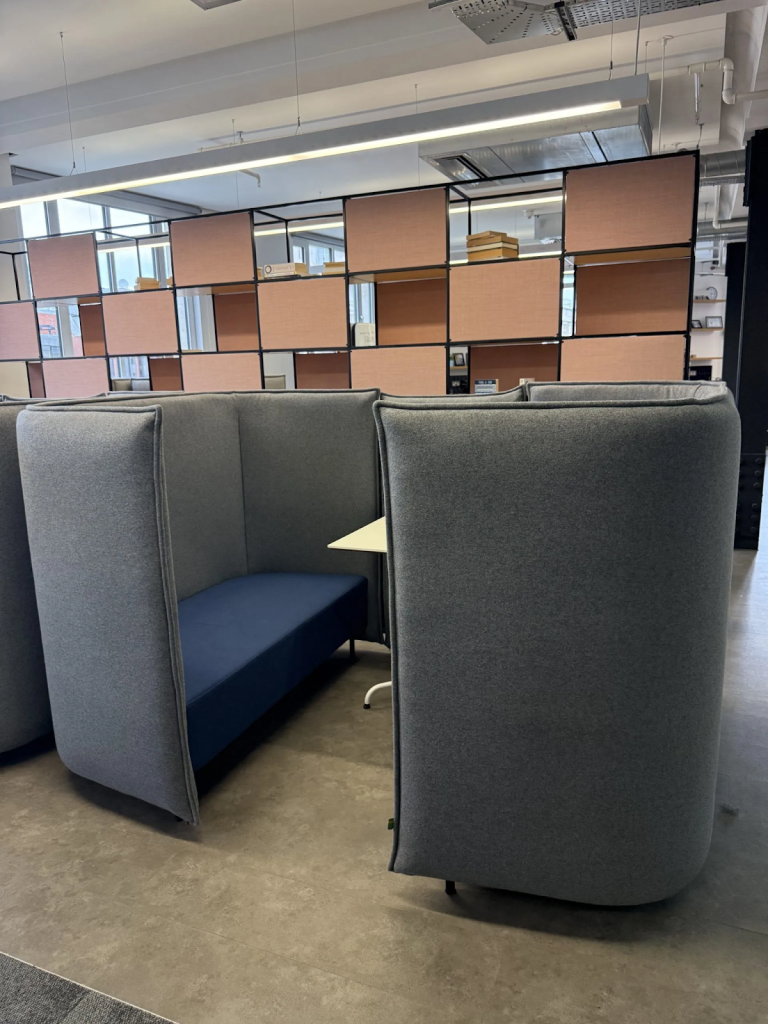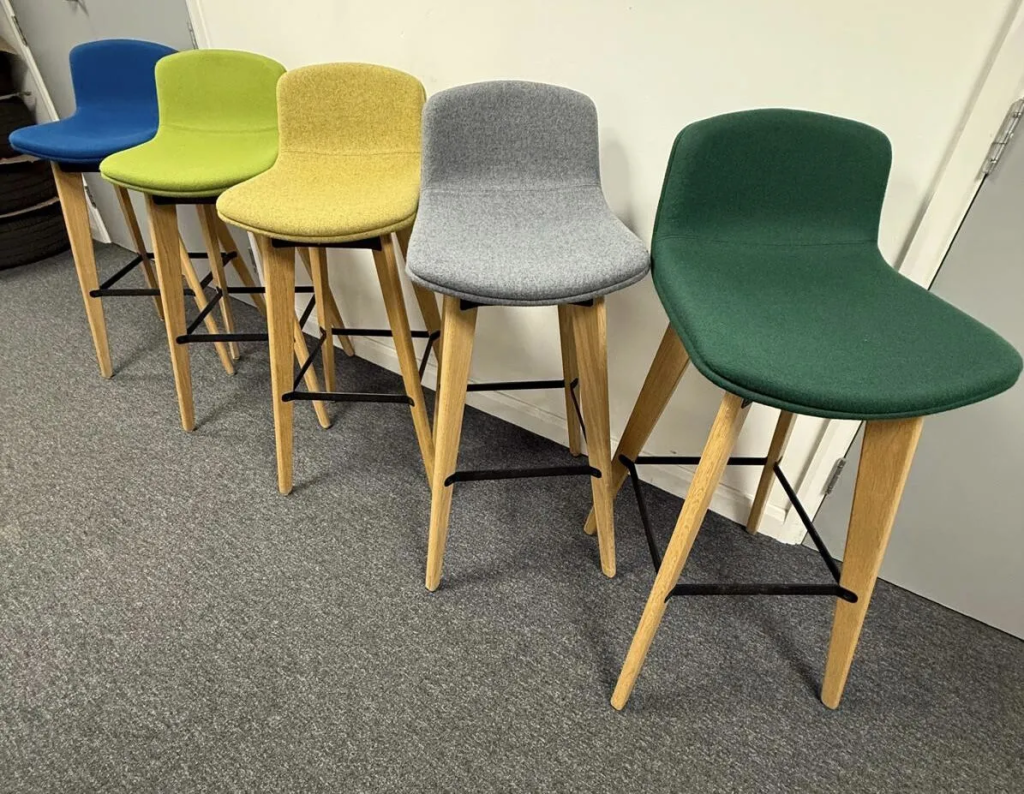Hybrid working has altered the rhythm of office life. Many people now move fluidly between home and shared workspaces, creating a new challenge for leaders: how to maintain a sense of belonging. At The Office Chair Man, we believe the physical environment plays a decisive part in this. Furniture choices influence how people interact, collaborate and feel connected.
An office that supports connection is not simply attractive; it is a cultural statement. Reused and refurbished furniture can strengthen that statement by demonstrating responsibility and care. Every desk, chair and pod becomes part of the organisational language, signalling what a team values most: openness, sustainability and wellbeing.
This article explores how well-designed furniture and thoughtful layouts foster connection in hybrid teams. It considers key principles of workplace design, zones that encourage interaction, and ways to measure cultural impact.
Did you know? Offices that adopt activity-based zones often report a shift toward more collaborative “clan” cultures after layout changes.

Hybrid teams often suffer from invisible divides. Those in the office may enjoy spontaneous exchanges, while remote colleagues can feel peripheral. Over time, these divides erode trust and engagement.
Connection relies on three conditions:
Furniture has a role in all three. Mobile tables enable quick re-grouping; adjustable seating encourages eye-level discussion; social corners invite informal updates that sustain awareness.
Without intentional design, hybrid workplaces risk becoming transactional rather than relational. By contrast, a carefully planned environment acts as a cultural anchor. It reminds people that collaboration is not an occasional event but a daily habit embedded in the space itself.

Space communicates values as clearly as policy documents do. Layout and furniture placement shape how people move, talk and share ideas. Open sight lines encourage transparency; enclosed zones provide psychological safety for focused work.
Environmental psychology highlights the effect of spatial cues: curved seating promotes cooperation, while rigid rows reinforce hierarchy. Furniture choices therefore send subtle messages about how a team is expected to behave.
Proxemics—the study of personal distance—suggests that arranging chairs slightly closer increases warmth and engagement. Similarly, shared surfaces such as large tables promote inclusion by removing barriers.
Culture flourishes when space balances autonomy and togetherness. A hybrid office should provide both: secluded pods for concentration and communal areas that draw people together naturally.
| Principle | Description | Example |
| Flexibility | Spaces that adapt to team size and activity | Modular desks and folding tables |
| Choice | Empower staff to select where they work best | Variety of seating heights and textures |
| Visibility | Support awareness without intrusion | Low partitions, transparent panels |
| Inclusivity | Equal comfort for all users | Ergonomic task chairs across levels |
| Acoustic balance | Manage noise without isolation | Acoustic screens and fabric booths |
| Psychological comfort | Spaces that reduce anxiety | Warm lighting, soft finishes |
Designing with these principles ensures the office remains dynamic rather than fixed. Reused high-quality furniture fits seamlessly into this approach, allowing teams to reconfigure layouts sustainably while maintaining professional standards.
Furniture reflects the personality of a business. A reclaimed oak table suggests longevity; a bright ergonomic chair conveys creativity and care for wellbeing.
The Office Chair Man’s commitment to quality reused furniture supports organisations that wish to combine aesthetics with ethics. Choosing pre-owned Herman Miller or Vitra chairs communicates value for craftsmanship and sustainability.
Cultural signals also appear through consistency. When every employee sits comfortably in a well-maintained task chair, hierarchy diminishes. Collaboration feels more genuine because the environment treats everyone equally.
Visual harmony, texture and comfort work together to tell employees, “You belong here.”

Compact desks, ergonomic chairs and privacy screens provide concentration without complete isolation.
Modular tables and writable surfaces support teamwork. Pairing these with mobile storage allows fast transitions between projects.
Soft seating and café-style tables encourage relaxed discussion. These areas often spark innovation through unplanned encounters.
Quiet lounges or armchairs help employees recharge.
Used office pods and booths from The Office Chair Man can be fitted with integrated power and screens, creating inclusive meeting points for on-site and remote participants alike.
Hybrid work relies on seamless technology. Furniture must support that by providing accessible power, cable management and appropriate acoustics.
Key features include:
Integrating these elements avoids the “technology divide” that isolates remote workers. A tidy, well-wired space also signals professionalism to clients and partners joining virtually.

Imagine two hybrid offices.
Office A retains its pre-pandemic layout: fixed desks, high screens, few social zones. Staff alternate days but rarely interact. Morale declines.
Office B invests in reconfigurable tables, refurbished ergonomic chairs and acoustic booths. Colleagues use café corners for informal catch-ups, while pods host video meetings without disruption. Engagement surveys improve and cross-team collaboration rises.
These scenarios show that connection grows when space invites participation. The Office Chair Man’s range of used pods, collaborative seating and acoustic furniture enables such transformation economically and sustainably.
Assessing cultural impact involves both numbers and stories.
Quantitative indicators:
Qualitative feedback:
Tracking these metrics over time demonstrates whether the workspace truly fosters connection.

Effective change begins with small steps:
Involving staff from the outset builds ownership and ensures the design fits real needs. Mixing refurbished and new pieces keeps budgets flexible while meeting environmental goals.
Regular maintenance and rotation of items extend lifespan, reducing waste. A partnership with The Office Chair Man provides access to expertly refurbished furniture and guidance on layout optimisation.
Reusing high-quality furniture reduces carbon emissions and landfill waste. It also reinforces a culture of responsibility.
Choosing refurbished pieces shows commitment to long-term thinking and fiscal prudence. Employees often feel proud to work in a space that mirrors their own environmental values.
At The Office Chair Man, every product—from task chairs to acoustic booths—is inspected and restored for continued performance, proving that sustainability and style can coexist.
Hybrid working is now the norm, but culture remains the glue that holds teams together. The design of an office—its layout, furniture and feel—can strengthen that glue when guided by intention.
The Office Chair Man champions environments where connection thrives through comfort, flexibility and responsible choice. By combining design insight with sustainable furniture, organisations can create workplaces that welcome collaboration and express care for both people and planet.
Connection is not built by chance; it is designed into every chair, table and pod.
Let The Office Chair Man help you create a workspace that connects, inspires and lasts — talk to our team today.
Furniture influences how people communicate and collaborate. In hybrid settings, the right mix of desks, chairs, and social spaces encourages connection between colleagues who may only meet in person a few days a week. A well-designed space helps teams feel part of the same culture, whether they are on-site or joining remotely.
Furniture that offers flexibility, comfort, and accessibility works best. Popular options include:
All of these are available in high-quality refurbished options at The Office Chair Man.
Choosing refurbished office furniture demonstrates a commitment to sustainability, responsibility, and quality. It signals that the business values both people and the planet. When employees see well-maintained, eco-conscious furnishings, they recognise that the organisation cares about long-term wellbeing rather than short-term trends.
Yes — provided they are carefully inspected and refurbished by professionals. The Office Chair Man restores every product to high performance and aesthetic standards. Reused items often come from premium brands such as Herman Miller, Steelcase, and Vitra, ensuring lasting durability and comfort at a fraction of the original cost.
Acoustic pods allow employees to take video calls, hold one-to-one conversations, or focus without distractions. In hybrid environments, they bridge the gap between in-office and remote staff by creating clear, private communication zones.
You can track both quantitative and qualitative data:
Over time, these indicators reveal whether the workspace truly supports connection and productivity.
Absolutely. Connection is about thoughtful layout, not size. Even compact spaces can include shared tables, lounge corners, or mini-pods that promote collaboration. Using modular, refurbished furniture helps maximise space while staying within budget.
Refurbished items cost significantly less than brand-new equivalents while maintaining professional quality. Extending the lifespan of existing furniture also reduces waste-disposal costs and aligns with corporate environmental goals.
Yes. We provide everything from individual ergonomic chairs to full suites of desks, tables, storage, and acoustic booths. Our specialists can advise on layout planning to create flexible zones for hybrid working.